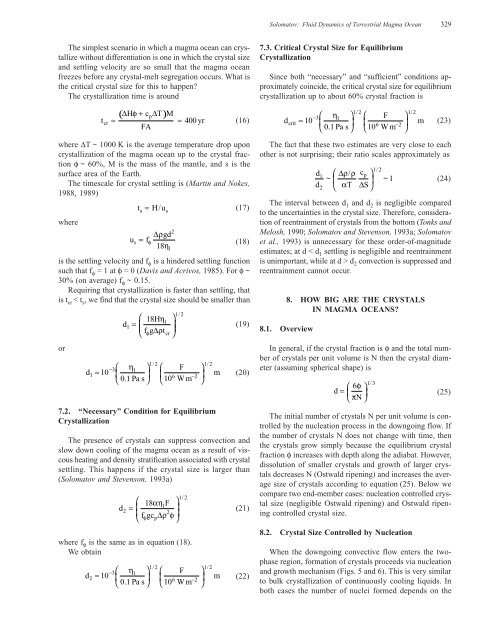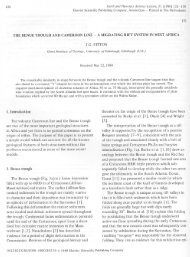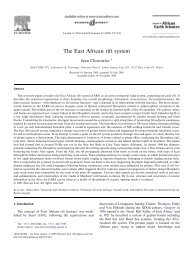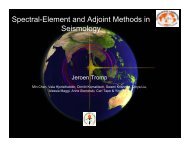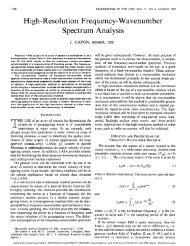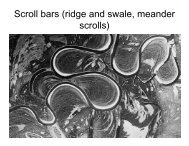Fluid Dynamics of a Terrestrial Magma Ocean - NMSU Geophysics ...
Fluid Dynamics of a Terrestrial Magma Ocean - NMSU Geophysics ...
Fluid Dynamics of a Terrestrial Magma Ocean - NMSU Geophysics ...
You also want an ePaper? Increase the reach of your titles
YUMPU automatically turns print PDFs into web optimized ePapers that Google loves.
Solomatov: <strong>Fluid</strong> <strong>Dynamics</strong> <strong>of</strong> <strong>Terrestrial</strong> <strong>Magma</strong> <strong>Ocean</strong> 329The simplest scenario in which a magma ocean can crystallizewithout differentiation is one in which the crystal sizeand settling velocity are so small that the magma oceanfreezes before any crystal-melt segregation occurs. What isthe critical crystal size for this to happen?The crystallization time is aroundtcr≈( )∆Hφ+ cp∆T MFA≈ 400 yr (16)where ∆T ~ 1000 K is the average temperature drop uponcrystallization <strong>of</strong> the magma ocean up to the crystal fractionφ ~ 60%, M is the mass <strong>of</strong> the mantle, and s is thesurface area <strong>of</strong> the Earth.The timescale for crystal settling is (Martin and Nokes,1988, 1989)ts≈ H/ us(17)where2∆ρgdus= f φ (18)18ηlis the settling velocity and f φ is a hindered settling functionsuch that f φ = 1 at φ = 0 (Davis and Acrivos, 1985). For φ ~30% (on average) f φ ~ 0.15.Requiring that crystallization is faster than settling, thatis t cr < t s , we find that the crystal size should be smaller thanord1≈ 10−3d1=12 /φ ∆ cr18Hηlfg ρtηl01 . Pa s 1012 / 12 /FWm6 −27.2. “Necessary” Condition for EquilibriumCrystallizationm(19)(20)The presence <strong>of</strong> crystals can suppress convection andslow down cooling <strong>of</strong> the magma ocean as a result <strong>of</strong> viscousheating and density stratification associated with crystalsettling. This happens if the crystal size is larger than(Solomatov and Stevenson, 1993a)d=18αηlFfgc φ p∆ρ φ2 212 /(21)7.3. Critical Crystal Size for EquilibriumCrystallizationSince both “necessary” and “sufficient” conditions approximatelycoincide, the critical crystal size for equilibriumcrystallization up to about 60% crystal fraction isdcrit≈ 10−3ηl01 . Pa s 1012 / 12 /FWm6 −2m(23)The fact that these two estimates are very close to eachother is not surprising; their ratio scales approximately asdd1212 /∆ρρ/ cp~ ~1αT∆S(24)The interval between d 1 and d 2 is negligible comparedto the uncertainties in the crystal size. Therefore, consideration<strong>of</strong> reentrainment <strong>of</strong> crystals from the bottom (Tonks andMelosh, 1990; Solomatov and Stevenson, 1993a; Solomatovet al., 1993) is unnecessary for these order-<strong>of</strong>-magnitudeestimates; at d < d 1 settling is negligible and reentrainmentis unimportant, while at d > d 2 convection is suppressed andreentrainment cannot occur.8. HOW BIG ARE THE CRYSTALSIN MAGMA OCEANS?8.1. OverviewIn general, if the crystal fraction is φ and the total number<strong>of</strong> crystals per unit volume is N then the crystal diameter(assuming spherical shape) isd = 6 13 /φπN(25)The initial number <strong>of</strong> crystals N per unit volume is controlledby the nucleation process in the downgoing flow. Ifthe number <strong>of</strong> crystals N does not change with time, thenthe crystals grow simply because the equilibrium crystalfraction φ increases with depth along the adiabat. However,dissolution <strong>of</strong> smaller crystals and growth <strong>of</strong> larger crystalsdecreases N (Ostwald ripening) and increases the averagesize <strong>of</strong> crystals according to equation (25). Below wecompare two end-member cases: nucleation controlled crystalsize (negligible Ostwald ripening) and Ostwald ripeningcontrolled crystal size.where f φ is the same as in equation (18).We obtaind2≈ 10−3ηl01 . Pa s 1012 / 12 /FWm6 −2m(22)8.2. Crystal Size Controlled by NucleationWhen the downgoing convective flow enters the twophaseregion, formation <strong>of</strong> crystals proceeds via nucleationand growth mechanism (Figs. 5 and 6). This is very similarto bulk crystallization <strong>of</strong> continuously cooling liquids. Inboth cases the number <strong>of</strong> nuclei formed depends on the


